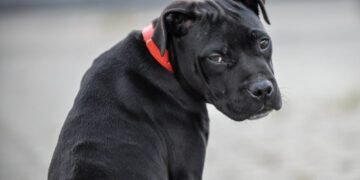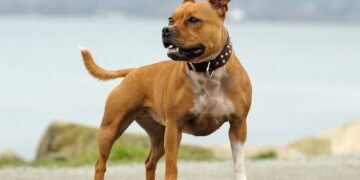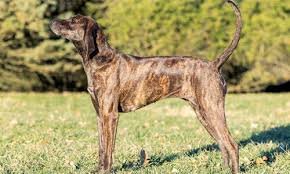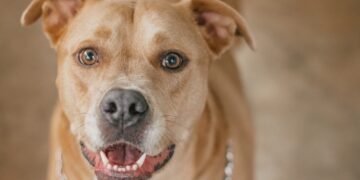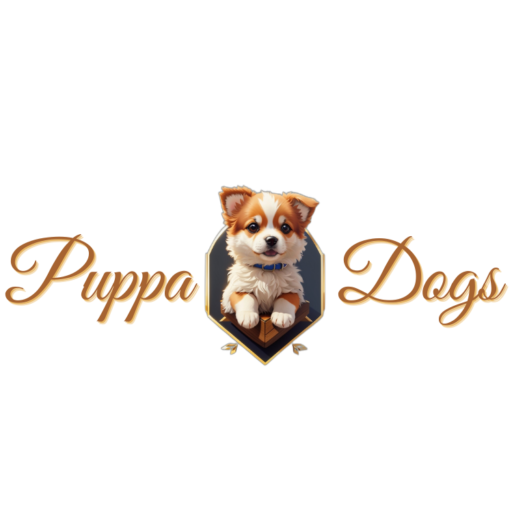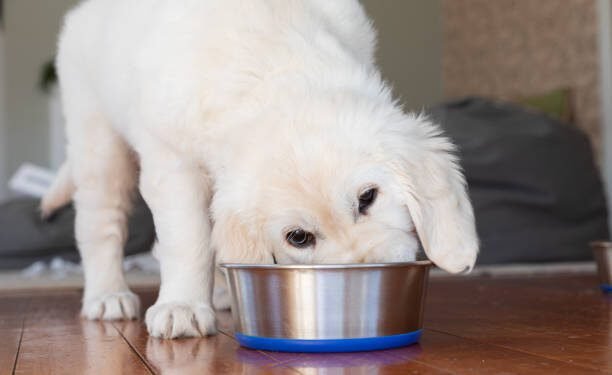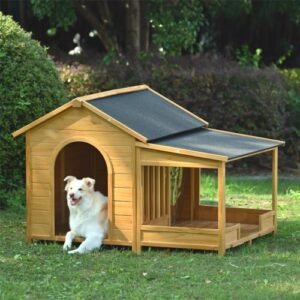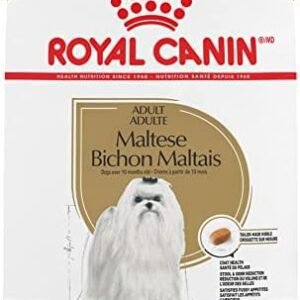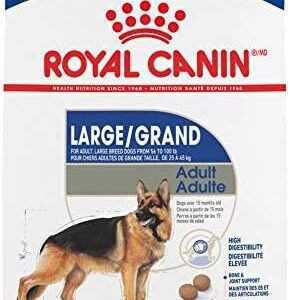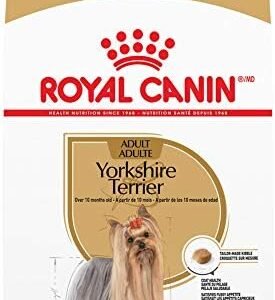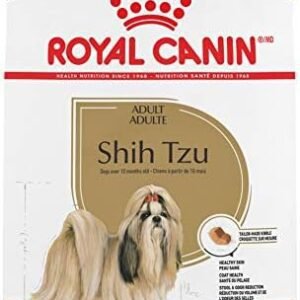If you are looking for a loyal, gentle, and majestic companion, you might want to consider the Great Pyrenees dog breed. These dogs are known for their thick, white coats that make them look like fluffy clouds. But don’t let their appearance fool you – they are also powerful and courageous guardians of their flock and family.
The Great Pyrenees dog breed originated in the Pyrenean Mountains between Spain and France, where they were used to protect sheep and other livestock from wolves and bears. They have a long history of working alongside humans, dating back to the Middle Ages. They were also favored by French nobility and royalty, who admired their beauty and elegance.
The Great Pyrenees dog breed is a large dog, typically weighing over 100 pounds and standing up to 32 inches at the shoulder. They have a double coat that consists of a long, coarse outer coat and a soft, dense undercoat. Their coat is mostly white, but may have markings of gray, tan, or badger on the head, ears, or body.
The Great Pyrenees dog breed has a calm and gentle temperament, especially around their loved ones. They are affectionate and loyal to their family, but may be wary of strangers. They are also independent and intelligent dogs, who can make their own decisions when guarding their flock. They are not very active dogs, but they do need regular exercise to stay healthy and happy.
The Great Pyrenees dog breed is generally healthy, but they may suffer from some health issues that are common in large breeds. Some of these issues include hip dysplasia, elbow dysplasia, patellar luxation, bone cancer, bloat, and deafness. They may also have skin problems if they live in hot or humid climates.
Because of their size and health issues, the Great Pyrenees dog breed needs a balanced and appropriate diet to support their health and well-being. A good diet can help prevent or manage some of the health problems that affect this breed, as well as provide them with the energy and nutrients they need for their daily activities.
In this article, we will review some of the best food products for the Great Pyrenees dog breed and provide some tips and recommendations on feeding them. We will also answer some of the most frequently asked questions about the Great Pyrenees dog breed’s diet.
Table of Contents
What are the best food products for the Great Pyrenees dog breed?

There are many factors to consider when choosing the best food products for your Great Pyrenees dog breed, such as their size, activity level, age, life stage, and any special dietary needs or preferences. Here are some of the best food products for the Great Pyrenees dog breed that we found on the web:
- The Farmer’s Dog Fresh Turkey: This is a fresh and human-grade food that is made with USDA-approved turkey as the first ingredient. It is nutritionally balanced and customized to your dog’s needs. It comes in pre-portioned frozen packages that you can thaw and serve easily. This food is ideal for Great Pyrenees who are active and need high-quality protein and antioxidants.
- Taste of the Wild Sierra Mountain Grain-Free: This is a dry food that is grain-free and contains lamb as the main source of protein. It also has fruits and vegetables that provide fiber, vitamins, and minerals. This food supports healthy digestion, skin, coat, and immune system for your Great Pyrenees.
- Nutro Ultra Adult Weight Management: This is a dry food that is specially formulated for large breed dogs who need to maintain a healthy weight. It has a blend of proteins from chicken, lamb, and salmon, as well as whole grains that keep your dog feeling full. It also has glucosamine and chondroitin to support joint health and mobility for your Great Pyrenees.
- The Honest Kitchen Limited Ingredient Diet: This is a dehydrated food that is made with 100% human-grade ingredients. It has free-range chicken as the first ingredient and only six other natural ingredients. It is easy to prepare by adding water and stirring. This food is ideal for Great Pyrenees who have food allergies or sensitivities, as it has no preservatives, fillers, GMO ingredients, or by-products.
- Blue Buffalo Wilderness Large Breed Puppy: This is a dry food that is designed for large breed puppies who need optimal nutrition for their growth and development. It has a high protein content from deboned chicken and chicken meal, as well as DHA from fish oil to support brain and eye development. It also has calcium and phosphorus to support strong bones and teeth for your Great Pyrenees puppy.
- LIMITED INGREDIENT & GRAIN FREE, WILD CAUGHT FISH: With just six whole food ingredients, The Honest Kitchen Limited Ingr…
- SUITABLE FOR PUPPIES & ADULT DOGS: Complete & Balanced nutrition for dogs of all life stages, breeds and sizes including…
- EASY HOMEMADE: Just add warm water for a wholesome & delicious meal. Serve alone as a complete meal for maximum nutritio…

















- Taste of the Wild Sierra Mountain with ROASTED LAMB dry dog food; REAL LAMB is the #1 ingredient; 25% protein to help su…
- Nutrient-rich and provides the energy to thrive; vitamins and minerals from SUPERFOODS; omega fatty acids for healthy SK…
- Each serving includes high levels of species-specific, K9 Strain PROPRIETARY PROBIOTICS – plus antioxidants and prebioti…
- Ultra Difference: Nutro Ultra Adult High Protein Dry Dog Food provides high-quality ingredients like our trio of animal …
- High-quality Protein: With real chicken as the #1 ingredient and high-quality protein from chicken sources, this dry dog…
- Radiant Skin & Coat: Nutro Ultra Adult High Protein Dry Dog Food with a Trio of Proteins from Chicken, Lamb, and Salmon …

















- REAL CHICKEN FIRST: This Blue Buffalo dog food is made with real, high-quality chicken as the #1 ingredient
- PACKED WITH FLAVOR AND NUTRITION: This dry dog food supports muscle development, skin and coat health, and immune system…
- IMMUNE SYSTEM SUPPORT: High-protein dog food contains exclusive, antioxidant-rich LifeSource Bits

















These are some of the best food products for the Great Pyrenees dog breed that we could find on the web. Of course, you should always consult your veterinarian before changing your dog’s diet, as they can advise you on the best food for your dog’s specific needs and preferences.
You should divide the daily amount into two meals, one in the morning and one in the evening. This will help prevent bloat, a life-threatening condition that occurs when the stomach fills with gas and twists. You should also avoid feeding your Great Pyrenees dog breed right before or after exercise, as this can also increase the risk of bloat.
You should also monitor your Great Pyrenees dog breed’s body condition regularly, as this will help you determine if they are getting enough or too much food. You can use the following chart to assess your dog’s body condition:
| Score | Description |
|---|---|
| 1 | Emaciated: Ribs, spine, and hip bones are visible. No fat or muscle mass. |
| 2 | Thin: Ribs, spine, and hip bones are easily felt. Little fat or muscle mass. |
| 3 | Ideal: Ribs and spine are felt but not seen. Hip bones are covered by a thin layer of fat. Waist is visible when viewed from above. Abdomen is tucked up when viewed from the side. |
| 4 | Overweight: Ribs and spine are hard to feel. Hip bones are buried under a thick layer of fat. Waist is barely visible or absent when viewed from above. Abdomen is sagging when viewed from the side. |
| 5 | Obese: Ribs and spine are impossible to feel. Hip bones are not detectable under a massive layer of fat. Waist is not visible when viewed from above. Abdomen is distended when viewed from the side. |
Your Great Pyrenees dog breed should have a body condition score of 3, which means they are at their ideal weight and shape. If they have a lower or higher score, you should adjust their diet accordingly, either by increasing or decreasing the amount or quality of food.
Choosing Food for Great Pyrenees based on Size and Activity Level


One of the most important factors to consider when choosing food for your Great Pyrenees dog breed is their size and activity level. Great Pyrenees are large and active dogs that require a high amount of calories and protein to meet their energy and growth needs. They also need a balanced diet that provides them with the essential vitamins, minerals, and fatty acids for their overall health and well-being.
How does size affect the diet of Great Pyrenees?
The size of your Great Pyrenees dog breed affects the amount and type of food they need. As a large breed, Great Pyrenees have a higher metabolic rate than smaller breeds, which means they burn more calories per day. They also have a larger body mass, which means they need more food to maintain their weight and condition.
According to the National Research Council, the average daily caloric requirement for a 100-pound adult Great Pyrenees dog breed is about 2,200 calories. However, this may vary depending on their age, activity level, health status, and individual factors. You should always consult your veterinarian to determine the exact caloric requirement for your Great Pyrenees dog breed.
The type of food you choose for your Great Pyrenees dog breed should also match their size. Large breeds like Great Pyrenees have a higher risk of developing joint problems, such as hip dysplasia or arthritis, due to their weight and growth rate. Therefore, they need food that contains adequate amounts of glucosamine and chondroitin, which are substances that support joint health and mobility.
Large breeds like Great Pyrenees also have a higher risk of developing bloat, a life-threatening condition that occurs when the stomach fills with gas and twists. Therefore, they need food that is easy to digest and does not cause excessive gas production. They also need food that is low in fat and sodium, which can contribute to obesity and heart problems.
How does activity level affect the diet of Great Pyrenees?
The activity level of your Great Pyrenees dog breed affects the quality and quantity of food they need. Great Pyrenees are active dogs that were bred to work as livestock guardians in harsh environments. They have a high stamina and endurance, which means they can perform physical tasks for long periods of time.
However, not all Great Pyrenees have the same activity level. Some may be more active than others, depending on their personality, lifestyle, and environment. Some may work as farm dogs or service dogs, while others may live as family pets or companions. Some may enjoy outdoor activities like hiking or swimming, while others may prefer indoor activities like playing or cuddling.
The activity level of your Great Pyrenees dog breed determines the amount of protein and carbohydrates they need in their diet. Protein is the building block of muscles, bones, skin, hair, and other tissues. It also helps repair damaged cells and tissues after exercise or injury. Carbohydrates are the main source of energy for the body. They provide fuel for the brain, muscles, and other organs.
According to the Association of American Feed Control Officials (AAFCO), the minimum protein requirement for adult dogs is 18%, while the minimum carbohydrate requirement is 30%. However, these percentages may vary depending on the activity level of your Great Pyrenees dog breed. Active dogs may need more protein and carbohydrates than less active dogs to support their energy and growth needs.
The quality of the protein and carbohydrates you choose for your Great Pyrenees dog breed also matters. You should look for food that contains high-quality protein from animal sources, such as chicken, lamb, turkey, or fish. These sources provide complete amino acids, which are the essential components of protein. You should avoid food that contains low-quality protein from plant sources, such as corn, wheat, or soy. These sources provide incomplete amino acids, which can cause deficiencies or allergies in dogs.
You should also look for food that contains complex carbohydrates from whole grains, fruits, or vegetables. These sources provide fiber, vitamins and minerals, which are essential for the health and function of the digestive system, immune system, and nervous system. You should avoid food that contains simple carbohydrates from sugars, syrups, or starches. These sources provide empty calories, which can cause obesity, diabetes, or dental problems in dogs.
Food products that are suitable for Great Pyrenees based on their size and activity level
There are many food products available on the market that are suitable for Great Pyrenees based on their size and activity level. However, not all of them are of the same quality or value. You should always read the labels and reviews of the food products before buying them, as they will tell you the ingredients, nutritional analysis, feeding guidelines, and customer feedback of the products.
Here are some examples of food products that we recommend for Great Pyrenees based on their size and activity level:
- The Farmer’s Dog Fresh Turkey: This is a fresh and human-grade food that is made with USDA-approved turkey as the first ingredient. It is nutritionally balanced and customized to your dog’s needs. It comes in pre-portioned frozen packages that you can thaw and serve easily. This food is ideal for Great Pyrenees who are active and need high-quality protein and antioxidants. It also contains glucosamine and chondroitin to support joint health and mobility, as well as probiotics and prebiotics to support digestive health and immunity.
- Taste of the Wild Sierra Mountain Grain-Free: This is a dry food that is grain-free and contains lamb as the main source of protein. It also has fruits and vegetables that provide fiber, vitamins, and minerals. This food supports healthy digestion, skin, coat, and immune system for your Great Pyrenees. It also contains omega-3 and omega-6 fatty acids to support brain and eye development, as well as antioxidants to protect against free radicals.
- Nutro Ultra Adult Weight Management: This is a dry food that is specially formulated for large breed dogs who need to maintain a healthy weight. It has a blend of proteins from chicken, lamb, and salmon, as well as whole grains that keep your dog feeling full. It also has glucosamine and chondroitin to support joint health and mobility for your Great Pyrenees. It also contains L-carnitine to help burn fat and maintain lean muscle mass, as well as vitamins and minerals to support overall health.
These are some of the best food products for Great Pyrenees based on their size and activity level that we could find on the web. However, you should always consult your veterinarian before changing your dog’s diet, as they can advise you on the best food for your dog’s specific needs and preferences.
Food for Great Pyrenees based on Age and Life Stage
Another factor to consider when choosing food for your Great Pyrenees dog breed is their age and life stage. Great Pyrenees have different nutritional requirements depending on their age and life stage, such as puppies, adults, seniors, pregnant or lactating females, etc. They need food that matches their developmental and physiological needs, as well as their changing appetite and metabolism.
How does age and life stage affect the diet of Great Pyrenees?
The age and life stage of your Great Pyrenees dog breed affects the amount and type of food they need. As they grow and mature, their nutritional needs change accordingly. Here are some of the common age and life stages of Great Pyrenees and how they affect their diet:
Puppies:
Puppies are the youngest and most active stage of Great Pyrenees. They need food that supports their rapid growth and development, as well as their high energy and curiosity. Puppies need more calories, protein, fat, calcium, phosphorus, and DHA than adult dogs. They also need food that is easy to chew and digest, as they have smaller mouths and stomachs. Puppies should be fed three to four times a day until they are six months old, then twice a day until they are one year old.
Adults:
Adults are the most stable and balanced stage of Great Pyrenees. They need food that maintains their optimal weight and condition, as well as their health and well-being. Adults need fewer calories, protein, fat, calcium, phosphorus, and DHA than puppies, but more than seniors. They also need food that is high in quality and variety, as they have more refined tastes and preferences. Adults should be fed twice a day, once in the morning and once in the evening.
Seniors:
Seniors are the oldest and most relaxed stage of Great Pyrenees. They need food that supports their aging process and prevents or manages some of the health issues that affect them, such as joint problems, obesity, or dental problems. Seniors need fewer calories, protein, fat, calcium, phosphorus, and DHA than adults, but more fiber, antioxidants, glucosamine, chondroitin, and omega-3 fatty acids. They also need food that is soft and moist, as they have weaker teeth and gums. Seniors should be fed twice a day, but with smaller portions than adults.
Pregnant or lactating females:
Pregnant or lactating females are the most demanding and special stage of Great Pyrenees. They need food that supports their reproductive function and the growth and development of their puppies. Pregnant or lactating females need more calories, protein, fat, calcium, phosphorus, and DHA than adults or seniors. They also need food that is palatable and digestible, as they may have nausea or loss of appetite. Pregnant females should be fed twice a day until the last three weeks of pregnancy, then three to four times a day until delivery. Lactating females should be fed three to four times a day until weaning.
The type of food you choose for your Great Pyrenees dog breed should also match their age and life stage. Different types of food have different nutritional profiles and benefits for different age and life stages. For example:
- Dry food: Dry food is the most common and convenient type of food for dogs. It has a long shelf life and is easy to store and serve. It also helps clean the teeth and gums of dogs by scraping off plaque and tartar. Dry food is suitable for all age and life stages of Great Pyrenees dog breed.
- Wet food: Wet food is a type of food that contains more moisture than dry food. It has a shorter shelf life and needs to be refrigerated after opening. It also has a stronger smell and taste than dry food, which can appeal to dogs who have a low appetite or are picky eaters. Wet food is suitable for seniors, pregnant or lactating females, or dogs who have dental or digestive problems.
- Fresh food: Fresh food is a type of food that is made with fresh and human-grade ingredients. It has a high moisture content and is rich in protein and antioxidants. It also has no preservatives, fillers, GMO ingredients, or by-products. Fresh food is suitable for active dogs, puppies, or dogs who have food allergies or sensitivities.
- Dehydrated food: Dehydrated food is a type of food that is made with raw or cooked ingredients that are dried and preserved. It has a low moisture content and is lightweight and compact. It also has a long shelf life and is easy to prepare by adding water and stirring. Dehydrated food is suitable for dogs who travel frequently, have digestive issues, or prefer raw food.
What are some examples of food products that are suitable for Great Pyrenees based on their age and life stage?
There are many food products available on the market that are suitable for Great Pyrenees based on their age and life stage. However, not all of them are of the same quality or value. You should always read the labels and reviews of the food products before buying them, as they will tell you the ingredients, nutritional analysis, feeding guidelines, and customer feedback of the products.
Here are some examples of food products that we recommend for Great Pyrenees based on their age and life stage:
- Blue Buffalo Wilderness Large Breed Puppy: This is a dry food that is designed for large breed puppies who need optimal nutrition for their growth and development. It has a high protein content from deboned chicken and chicken meal, as well as DHA from fish oil to support brain and eye development. It also has calcium and phosphorus to support strong bones and teeth for your Great Pyrenees puppy. It also contains omega-3 and omega-6 fatty acids to support skin and coat health, as well as antioxidants to support immune system health.
- Nutro Ultra Adult Weight Management: This is a dry food that is specially formulated for large breed dogs who need to maintain a healthy weight. It has a blend of proteins from chicken, lamb, and salmon, as well as whole grains that keep your dog feeling full. It also has glucosamine and chondroitin to support joint health and mobility for your Great Pyrenees. It also contains L-carnitine to help burn fat and maintain lean muscle mass, as well as vitamins and minerals to support overall health.
- The Honest Kitchen Limited Ingredient Diet: This is a dehydrated food that is made with 100% human-grade ingredients. It has free-range chicken as the first ingredient and only six other natural ingredients. It is easy to prepare by adding water and stirring. This food is ideal for Great Pyrenees who have food allergies or sensitivities, as it has no preservatives, fillers, GMO ingredients, or by-products. It also contains omega-3 fatty acids to support skin and coat health, as well as probiotics to support digestive health and immunity.
- The Farmer’s Dog Fresh Turkey: This is a fresh and human-grade food that is made with USDA-approved turkey as the first ingredient. It is nutritionally balanced and customized to your dog’s needs. It comes in pre-portioned frozen packages that you can thaw and serve easily. This food is ideal for Great Pyrenees who are active and need high-quality protein and antioxidants. It also contains glucosamine and chondroitin to support joint health and mobility, as well as probiotics and prebiotics to support digestive health and immunity.
These are some of the best food products for Great Pyrenees based on their age and life stage that we could find on the web. However, you should always consult your veterinarian before changing your dog’s diet, as they can advise you on the best food for your dog’s specific needs and preferences.
- Precise balance and highly digestible ingredients for sensitive stomachs and for dogs with sensitive skin
- Prebiotic fiber to fuel beneficial gut bacteria and support a balanced microbiome
- Omega-6s & Vitamin E to promote a healthy coat

















- LIMITED INGREDIENT & GRAIN FREE, WILD CAUGHT FISH: With just six whole food ingredients, The Honest Kitchen Limited Ingr…
- SUITABLE FOR PUPPIES & ADULT DOGS: Complete & Balanced nutrition for dogs of all life stages, breeds and sizes including…
- EASY HOMEMADE: Just add warm water for a wholesome & delicious meal. Serve alone as a complete meal for maximum nutritio…

















- Ultra Difference: Nutro Ultra Adult Weight Management High Protein Dry Dog Food provides high-quality ingredients like o…
- High-quality Protein: With real chicken as the #1 ingredient and high-quality protein from chicken sources, this dry dog…
- Healthy Weight Loss: Nutro Ultra Adult Weight Management High Protein Dry Dog Food has tailored protein and fat to suppo…

















- REAL MEAT FIRST: This Blue Buffalo natural dry dog food is made with real, high-quality chicken as the #1 ingredient
- NUTRITION FOR LARGE BREED DOGS: This large breed dry dog food promotes lean muscles with L-Carnitine, and it supports jo…
- IMMUNE SYSTEM SUPPORT: This large breed dog food features exclusive antioxidant-rich LifeSource Bits

















Choosing Food for Great Pyrenees based on Special Dietary Needs and Preferences
Another factor to consider when choosing food for your Great Pyrenees dog breed is their special dietary needs and preferences. Great Pyrenees may have some special dietary needs or preferences due to their health conditions, allergies, sensitivities, or personal tastes. They need food that meets their specific requirements and satisfies their unique palates.
How do special dietary needs and preferences affect the diet of Great Pyrenees?
The special dietary needs and preferences of your Great Pyrenees dog breed affect the type and quality of food they need. Some of the common special dietary needs and preferences of Great Pyrenees are:
- Health conditions: Some Great Pyrenees may have health conditions that require a special diet to prevent or manage them. For example, some Great Pyrenees may have diabetes, which is a condition that affects the blood sugar levels in the body. They need food that is low in sugar and high in fiber, which can help regulate their blood sugar levels. They also need food that is high in protein and low in fat, which can help maintain their muscle mass and prevent obesity.
- Allergies: Some Great Pyrenees may have allergies to certain foods or ingredients, which can cause itching, rashes, vomiting, diarrhea, or anaphylaxis. They need food that is free of the allergens that trigger their reactions. Some of the common allergens for dogs are beef, chicken, dairy, eggs, wheat, corn, soy, and fish.
- Sensitivities: Some Great Pyrenees may have sensitivities to certain foods or ingredients, which can cause mild discomfort, gas, bloating, or indigestion. They need food that is gentle on their stomach and digestive system. Some of the common sensitivities for dogs are grains, gluten, artificial colors, flavors, or preservatives.
- Personal tastes: Some Great Pyrenees may have personal tastes that influence their food choices. They may prefer certain flavors, textures, or temperatures of food over others. They may also have likes or dislikes for certain foods or ingredients based on their past experiences or associations.
The type and quality of food you choose for your Great Pyrenees dog breed should match their special dietary needs and preferences. You should look for food that contains high-quality ingredients that are suitable for your dog’s condition, allergy, sensitivity, or taste. You should also avoid food that contains low-quality ingredients that are harmful or unsuitable for your dog’s condition, allergy, sensitivity, or taste.
Food products that are suitable for Great Pyrenees based on their special dietary needs or preferences
There are many food products available on the market that are suitable for Great Pyrenees based on their special dietary needs or preferences. However, not all of them are of the same quality or value. You should always read the labels and reviews of the food products before buying them, as they will tell you the ingredients, nutritional analysis, feeding guidelines, and customer feedback of the products.
Here are some examples of food products that we recommend for Great Pyrenees based on their special dietary needs or preferences:
- The Honest Kitchen Limited Ingredient Diet: This is a dehydrated food that is made with 100% human-grade ingredients. It has free-range chicken as the first ingredient and only six other natural ingredients. It is easy to prepare by adding water and stirring. This food is ideal for Great Pyrenees who have food allergies or sensitivities, nutrition and not becoming overweight or underweight. You can use the following methods to monitor and adjust the diet of your Great Pyrenees dog breed:
- Weigh your Great Pyrenees dog breed regularly: You should weigh your Great Pyrenees dog breed at least once a month to track their weight changes and trends. You can use a digital scale or a measuring tape to measure their weight and body length. You can also use a body condition score chart to assess their weight and shape visually. You should aim for a body condition score of 3, which means they are at their ideal weight and shape. If they have a lower or higher score, you should adjust their diet accordingly, either by increasing or decreasing the amount or quality of food.
- Check their stool quality and frequency: You should check the stool quality and frequency of your Great Pyrenees dog breed daily to monitor their digestive health and function. You can use a stool score chart to evaluate their stool consistency, color, and odor. You should aim for a stool score of 2 or 3, which means they have a firm and moist stool that is easy to pick up. If they have a lower or higher score, you should adjust their diet accordingly, either by adding more or less fiber, moisture, or probiotics to their food.
- Observe their behavior and mood: You should observe the behavior and mood of your Great Pyrenees dog breed daily to monitor their mental health and well-being. You can look for signs of hunger, thirst, satisfaction, boredom, stress, or pain in their body language, vocalization, and activity level. You should aim for a balanced and happy behavior and mood, which means they are alert, playful, curious, and affectionate. If they show signs of imbalance or distress, you should adjust their diet accordingly, either by changing the type or variety of food, adding more or less treats or supplements, or consulting a veterinarian.
These are some of the methods you can use to monitor and adjust the diet of your Great Pyrenees dog breed. Remember to always consult your veterinarian before changing your dog’s diet, as they can advise you on the best food for your dog’s specific needs and preferences.
How Much and How Often to Feed Great Pyrenees
One of the most common questions that Great Pyrenees owners have is how much and how often to feed their dogs. Feeding your Great Pyrenees the right amount and frequency of food is essential for their health and well-being. Feeding them too much or too little can cause problems such as obesity, malnutrition, bloat, or diabetes.
How to determine the appropriate amount and frequency of feeding Great Pyrenees?
The appropriate amount and frequency of feeding your Great Pyrenees will depend on several factors, such as their weight, age, activity level, and food type. You should always follow the feeding instructions on the food package, as they will provide you with the recommended serving size and feeding schedule for your dog.
However, these instructions are only general guidelines and may not suit your dog’s individual needs and preferences. You should also consult your veterinarian to determine the exact amount and frequency of feeding your Great Pyrenees, as they can advise you based on your dog’s specific condition and lifestyle.
As a general guideline, you can use the following table to estimate how much and how often to feed your Great Pyrenees based on their weight and food type:
| Weight | Dry Food | Fresh Food |
|---|---|---|
| 50 lbs | 2-3 cups per day | 5% of body weight per day |
| 75 lbs | 3-4 cups per day | 7.5% of body weight per day |
| 100 lbs | 4-5 cups per day | 10% of body weight per day |
| 125 lbs | 5-6 cups per day | 12.5% of body weight per day |
You should divide the daily amount into two meals, one in the morning and one in the evening. This will help prevent bloat, a life-threatening condition that occurs when the stomach fills with gas and twists. You should also avoid feeding your Great Pyrenees right before or after exercise, as this can also increase the risk of bloat.
You should also adjust the amount and frequency of feeding your Great Pyrenees based on their age and activity level. For example:
- Puppies: Puppies need more food than adults, as they are growing and developing rapidly. You should feed them three to four times a day until they are six months old, then twice a day until they are one year old. You should also increase the amount of food gradually as they grow, until they reach their adult weight.
- Adults: Adults need less food than puppies, as they have reached their mature size and shape. You should feed them twice a day, once in the morning and once in the evening. You should also maintain a consistent amount of food, unless they become overweight or underweight.
- Seniors: Seniors need less food than adults, as they have a slower metabolism and lower activity level. You should feed them twice a day, but with smaller portions than adults. You should also reduce the amount of food if they become overweight or increase it if they become underweight.
- Pregnant or lactating females: Pregnant or lactating females need more food than adults, as they are supporting their reproductive function and the growth and development of their puppies. You should feed them twice a day until the last three weeks of pregnancy, then three to four times a day until delivery. You should also increase the amount of food gradually as their pregnancy progresses, until they reach about 50% more than their normal amount. Lactating females should be fed three to four times a day until weaning. You should also increase the amount of food gradually as their milk production increases, until they reach about twice their normal amount.
What are some tips on how to measure and serve the food for Great Pyrenees?
There are some tips on how to measure and serve the food for your Great Pyrenees dog breed, such as:
- Use a measuring cup or a scale to measure the exact amount of food for your Great Pyrenees dog breed. Do not use your eyes or hands to estimate the amount, as this can lead to overfeeding or underfeeding.
- Use a clean and dry bowl to serve the food for your Great Pyrenees dog breed. Do not use a plastic bowl, as this can harbor bacteria or leach chemicals into the food. Use a stainless steel or ceramic bowl instead, as these are more durable and hygienic.
- Use warm water to moisten the dry food for your Great Pyrenees dog breed. This will make it more palatable and digestible for them. Do not use hot water, as this can destroy some of the nutrients in the food. Do not use milk or broth, as these can cause diarrhea or allergies in some dogs.
- Use a spoon or a fork to mix the fresh or dehydrated food for your Great Pyrenees dog breed. This will ensure that all the ingredients are evenly distributed and blended. Do not use your hands, as this can contaminate the food or cause injuries to your fingers.
- Use a timer or a clock to keep track of the feeding time for your Great Pyrenees dog breed. This will help you maintain a regular and consistent feeding schedule for them. Do not feed them at random or irregular times, as this can cause confusion or stress in them.
These are some of the tips on how to measure and serve the food for your Great Pyrenees dog breed. Remember to always consult your veterinarian before changing your dog’s diet, as they can advise you on the best food for your dog’s specific needs and preferences.
What to Avoid Feeding Great Pyrenees
While feeding your Great Pyrenees the right food is essential for their health and well-being, avoiding feeding them the wrong food is equally important. There are some foods or ingredients that are harmful or toxic for Great Pyrenees, as they can cause serious health problems or even death. You should be aware of these foods or ingredients and prevent your Great Pyrenees from ingesting them.
What are some foods or ingredients that are harmful or toxic for Great Pyrenees?
There are many foods or ingredients that are harmful or toxic for Great Pyrenees, but some of the most common ones are:
- Chocolate: Chocolate contains a substance called theobromine, which can cause vomiting, diarrhea, tremors, seizures, and even death in dogs. The darker the chocolate, the more theobromine it contains. Even a small amount of chocolate can be fatal for a large dog like Great Pyrenees.
- Grapes and raisins: Grapes and raisins can cause kidney failure in dogs, even in small amounts. The exact mechanism of toxicity is unknown, but it may be related to a compound in the grapes or raisins that damages the kidney cells. Kidney failure can cause symptoms such as lethargy, loss of appetite, vomiting, dehydration, and increased thirst and urination.
- Onions and garlic: Onions and garlic can damage the red blood cells in dogs, leading to anemia. Anemia can cause symptoms such as weakness, pale gums, rapid breathing, and increased heart rate. Onions and garlic can be found in many human foods, such as sauces, soups, salads, or pizza.
- Xylitol: Xylitol is an artificial sweetener that can cause a sudden drop in blood sugar and liver failure in dogs. Xylitol can be found in many sugar-free products, such as gum, candy, baked goods, or toothpaste. A low blood sugar level can cause symptoms such as weakness, confusion, seizures, or coma. Liver failure can cause symptoms such as jaundice, vomiting, bleeding, or death.
- Macadamia nuts: Macadamia nuts can cause weakness, tremors, and paralysis in dogs. The exact mechanism of toxicity is unknown, but it may be related to a compound in the macadamia nuts that affects the nervous system. The symptoms usually appear within 12 hours of ingestion and last for up to 48 hours.
- Alcohol: Alcohol can cause intoxication, vomiting, diarrhea, coma, and death in dogs. Alcohol can be found in many beverages, such as beer, wine, liquor, or cocktails. It can also be found in some foods, such as desserts, sauces, or breads. Alcohol affects the brain and liver of dogs, causing symptoms such as staggering, drooling, depression, or breathing difficulties.
These are some of the foods or ingredients that are harmful or toxic for Great Pyrenees dog breed. However, there are other foods or ingredients that may be harmful or toxic for Great Pyrenees dog breed, such as bones, raw meat or eggs, avocado, caffeine, or salt. You should always check the labels of any food or treats that you give to your Great Pyrenees dog breed, as they may contain some of these harmful or toxic ingredients.
How to prevent accidental ingestion of harmful foods or substances by Great Pyrenees?
The best way to prevent accidental ingestion of harmful foods or substances by your Great Pyrenees dog breed is to keep them away from them. You can use the following tips to prevent accidental ingestion of harmful foods or substances by your Great Pyrenees dog breed:
- Keep human food out of reach of your Great Pyrenees dog breed. Do not leave any food on the table, counter, or floor where your Great Pyrenees dog breed can access it. Do not feed your Great Pyrenees dog breed any human food, unless you are sure that it is safe and suitable for them.
- Keep trash cans secured and covered. Do not let your Great Pyrenees dog breed rummage through the trash, as they may find and eat something harmful or toxic. Use a trash can with a lid that locks or a latch that prevents your Great Pyrenees dog breed from opening it.
- Keep plants that may contain toxins away from your Great Pyrenees dog breed. Do not let your Great Pyrenees dog breed chew on or ingest any plants that may contain toxins, such as lilies, azaleas, oleanders, or sago palms. Use a fence or a barrier to keep your Great Pyrenees dog breed away from these plants, or remove them from your home or garden.
- Keep medications and household products out of reach of your Great Pyrenees dog breed. Do not let your Great Pyrenees dog breed access any medications or household products that may be harmful or toxic for them, such as painkillers, antifreeze, bleach, or rat poison. Store these items in a cabinet or a drawer that locks or has a child-proof latch.
- Keep an eye on your Great Pyrenees dog breed when they are outside. Do not let your Great Pyrenees dog breed roam freely outside, as they may encounter and eat something harmful or toxic. Supervise your Great Pyrenees dog breed when they are outside, or use a leash or a fence to keep them within your sight.
These are some of the tips on how to prevent accidental ingestion of harmful foods or substances by your Great Pyrenees dog breed. Remember to always consult your veterinarian if you suspect that your Great Pyrenees dog breed has eaten something harmful or toxic, as they can provide you with the best treatment and care.
How to Monitor and Adjust the Diet of Great Pyrenees
One of the most important aspects of feeding your Great Pyrenees dog breed is to monitor and adjust their diet regularly. Monitoring and adjusting their diet can help you ensure that they are getting adequate nutrition and not becoming overweight or underweight. Overweight or underweight dogs can suffer from various health problems, such as joint issues, diabetes, heart disease, or reduced lifespan.
How to monitor the health and weight of Great Pyrenees?
There are several ways to monitor the health and weight of your Great Pyrenees dog breed, such as:
- Weigh your Great Pyrenees dog breed regularly: You should weigh your Great Pyrenees dog breed at least once a month to track their weight changes and trends. You can use a digital scale or a measuring tape to measure their weight and body length. You can also use a body condition score chart to assess their weight and shape visually. You should aim for a body condition score of 3, which means they are at their ideal weight and shape. If they have a lower or higher score, you should adjust their diet accordingly, either by increasing or decreasing the amount or quality of food.
- Check their stool quality and frequency: You should check the stool quality and frequency of your Great Pyrenees dog breed daily to monitor their digestive health and function. You can use a stool score chart to evaluate their stool consistency, color, and odor. You should aim for a stool score of 2 or 3, which means they have a firm and moist stool that is easy to pick up. If they have a lower or higher score, you should adjust their diet accordingly, either by adding more or less fiber, moisture, or probiotics to their food.
- Observe their behavior and mood: You should observe the behavior and mood of your Great Pyrenees dog breed daily to monitor their mental health and well-being. You can look for signs of hunger, thirst, satisfaction, boredom, stress, or pain in their body language, vocalization, and activity level. You should aim for a balanced and happy behavior and mood, which means they are alert, playful, curious, and affectionate. If they show signs of imbalance or distress, you should adjust their diet accordingly, either by changing the type or variety of food, adding more or less treats or supplements, or consulting a veterinarian.
- Visit your veterinarian regularly: You should visit your veterinarian regularly to monitor the health and weight of your Great Pyrenees dog breed. Your veterinarian can perform a physical examination, blood tests, urine tests, or other tests to check for any signs of illness or disease in your Great Pyrenees dog breed. Your veterinarian can also advise you on the best diet for your Great Pyrenees dog breed based on their age, activity level, health status, and individual factors.
These are some of the ways to monitor the health and weight of your Great Pyrenees dog breed. Remember to always consult your veterinarian before changing your dog’s diet, as they can provide you with the best guidance and care.
How to adjust the diet of Great Pyrenees if needed?
If you notice that your Great Pyrenees dog breed is overweight or underweight, or has any health issues that require a special diet, you should adjust their diet accordingly. There are several ways to adjust the diet of your Great Pyrenees dog breed if needed, such as:
1.Consult your veterinarian: The first step to adjust the diet of your Great Pyrenees dog breed is to consult your veterinarian. Your veterinarian can diagnose the cause of your dog’s weight or health problem and prescribe the best diet for them. Your veterinarian can also recommend the appropriate amount and frequency of feeding for your Great Pyrenees dog breed based on their condition and lifestyle.
2. Switch to a different food product: The second step to adjust the diet of your Great Pyrenees dog breed is to switch to a different food product that suits their needs and preferences. You should look for food products that are specially formulated for large breed dogs who have specific weight or health issues. For example,
- If your Great Pyrenees dog breed is overweight, you should look for food products that are low in calories and fat but high in protein and fiber. These products can help your Great Pyrenees dog breed lose weight while maintaining lean muscle mass and feeling full. Some examples of these products are Nutro Ultra Adult Weight Management or Hill’s Science Diet Adult Perfect Weight.
- If your Great Pyrenees dog breed is underweight, you should look for food products that are high in calories and fat but low in carbohydrates. These products can help your Great Pyrenees dog breed gain weight while providing them with enough energy and nutrients. Some examples of these products are Purina Pro Plan Sport Performance 30/20 or Eukanuba Premium Performance 30/20.
- If your Great Pyrenees dog breed has joint problems, you should look for food products that contain glucosamine and chondroitin, which are substances that support joint health and mobility. These products can help your Great Pyrenees dog breed reduce inflammation and pain in their joints and improve their range of motion. Some examples of these products are The Farmer’s Dog Fresh Turkey or Royal Canin Large Joint Care.
- If your Great Pyrenees dog breed has food allergies or sensitivities, you should look for food products that are free of the allergens or irritants that trigger their reactions. These products can help your Great Pyrenees dog breed avoid itching, rashes, vomiting, diarrhea, or anaphylaxis. Some examples of these products are The Honest Kitchen Limited Ingredient Diet or Wellness Simple Limited Ingredient Diet.
- REAL CHICKEN FIRST: Blue Buffalo’s premium dog food features high quality deboned chicken as the primary ingredient; bro…
- HIGH QUALITY NATURAL FOOD: BLUE’s natural dry dog food is made with premium ingredients and contains no chicken or poult…
- THE PERFECT BALANCE OF FLAVOR AND NUTRITION: Formulated with essential proteins and carbs for energy needs and Omega-3 &…

















- FOR CANINE ATHLETES: Eukanuba Premium Performance 26/16 EXERCISE Dry Dog Food for adult dogs delivers optimal energy for…
- SUPPORT POST-EXERCISE RECOVERY: High protein dog food with a minimum of 26% protein and 16% fat and has antioxidants to …
- HEALTHY JOINT FUNCTION: Exercise dog food formula contains glucosamine, chondroitin sulfate and EPA to promote agile joi…

















- Concentrated nutrition optimizes oxygen metabolism (VO2 MAX) for increased endurance
- High protein formula, with real chicken as the first ingredient
- Used to be known as SPORT Performance 30/20 Formula

















- High quality protein for lean muscles
- Natural fibers for healthy digestion
- Omega-6s and vitamin E for beautiful skin & coat

















- High quality protein for lean muscles
- Natural fibers for healthy digestion
- Omega-6s and vitamin E for beautiful skin & coat

















When switching to a different food product, you should do it gradually and carefully. You should start by mixing a small amount of the new food with the old food, and then increase the proportion of the new food over a period of 7 to 10 days. This will help your Great Pyrenees dog breed adjust to the new food and prevent any digestive upset.
3. Add supplements or treats: The third step to adjust the diet of your Great Pyrenees dog breed is to add supplements or treats that can enhance their nutrition and well-being. You should look for supplements or treats that are natural, safe, and beneficial for your Great Pyrenees dog breed. For example,
- If your Great Pyrenees dog breed needs more omega-3 fatty acids, which are essential for skin, coat, brain, and eye health, you can add fish oil or flaxseed oil to their food. You can also give them fish-based treats, such as salmon or sardines.
- If your Great Pyrenees dog breed needs more probiotics, which are beneficial bacteria that support digestive health and immunity, you can add yogurt or kefir to their food. You can also give them probiotic supplements, such as Purina FortiFlora or Zesty Paws Probiotic Bites.
- If your Great Pyrenees dog breed needs more antioxidants, which are substances that protect against free radicals and oxidative stress, you can add berries or green leafy vegetables to their food. You can also give them antioxidant supplements, such as Zesty Paws Turmeric Curcumin Bites or PetHonesty 10 in 1 Multivitamin.
- Number one probiotic supplement recommended by veterinarians (Kantar Veterinary Tracker, 2020)
- Probiotic supplement for the dietary management of puppies and adult dogs with diarrhea
- Contains a probiotic for dogs proven to promote intestinal health and balance

















- Good Gut Bacteria – These chewables include pawsome probiotic strains such as Lactobacillus acidophilus, L. plantarum, L…
- Something Yummy for a Happy Tummy! – Probiotic Bites are functional soft chew dog supplements that support gut flora and…
- Featuring DE111 – This chewable supplement contains DE111, which is a clinically studied Bacillus subtilis that supports…

















- Number one probiotic supplement recommended by veterinarians (Kantar Veterinary Tracker, 2020)
- Probiotic supplement for the dietary management of puppies and adult dogs with diarrhea
- Contains a probiotic for dogs proven to promote intestinal health and balance

















- Good Gut Bacteria – These chewables include pawsome probiotic strains such as Lactobacillus acidophilus, L. plantarum, L…
- Something Yummy for a Happy Tummy! – Probiotic Bites are functional soft chew dog supplements that support gut flora and…
- Featuring DE111 – This chewable supplement contains DE111, which is a clinically studied Bacillus subtilis that supports…

















- Sea the Difference! – With Omega-3 fatty acids plus antioxidants, Salmon Bites support skin health, provides dog itching…
- Featuring DHAgold – This algae-derived source of DHA (Docosahexaenoic Acid), an Omega-3 fatty acid that supports skin he…
- Made with Wild Alaskan Salmon Fish Oil for Dogs Skin and Coat – Includes 120 mg per chew to provide Omega-3 fatty acids …
When adding supplements or treats to your Great Pyrenees dog breed’s diet, you should do it sparingly and moderately. You should not exceed the recommended dosage or frequency of the supplements or treats, as this can cause adverse effects or toxicity. You should also consult your veterinarian before giving any supplements or treats to your Great Pyrenees dog breed, as they can advise you on the best ones for them.
These are some of the ways to adjust the diet of your Great Pyrenees dog breed if needed. Remember to always consult your veterinarian before changing your dog’s diet, as they can provide you with the best guidance and care.
FAQs about dietary preference and food products for Great Pyrenees:
Q: What are the benefits of feeding fresh food to Great Pyrenees?
A: Fresh food is a type of food that is made with fresh and human-grade ingredients. It has a high moisture content and is rich in protein and antioxidants. It also has no preservatives, fillers, GMO ingredients, or by-products. Fresh food can benefit Great Pyrenees by providing them with high-quality nutrition, enhancing their taste and appetite, improving their digestion and immunity, and reducing their risk of allergies or sensitivities.
Q: What are the drawbacks of feeding dry food to Great Pyrenees?
A: Dry food is the most common and convenient type of food for dogs. It has a long shelf life and is easy to store and serve. It also helps clean the teeth and gums of dogs by scraping off plaque and tartar. However, dry food can also have some drawbacks for Great Pyrenees, such as being low in moisture and high in carbohydrates, which can cause dehydration or obesity. Dry food can also contain low-quality ingredients, such as corn, wheat, soy, or by-products, which can cause deficiencies or allergies in some dogs.
Q: How can I make my own homemade food for Great Pyrenees?
A: Making your own homemade food for Great Pyrenees can be a rewarding and cost-effective way to feed your dog. However, it can also be challenging and time-consuming, as you need to ensure that the food is balanced and complete for your dog’s needs. You also need to follow strict hygiene and safety standards to prevent contamination or spoilage. If you want to make your own homemade food for Great Pyrenees, you should consult your veterinarian or a canine nutritionist first. They can help you design a suitable recipe and advise you on the proper ingredients, portions, supplements, and cooking methods.
Q: What are some common food allergies or sensitivities in Great Pyrenees?
A: Food allergies or sensitivities are adverse reactions to certain foods or ingredients that can cause itching, rashes, vomiting, diarrhea, or anaphylaxis in dogs. Some of the common food allergies or sensitivities in Great Pyrenees are beef, chicken, dairy, eggs, wheat, corn, soy, and fish. These ingredients can trigger an immune response or an inflammatory response in some dogs. If you suspect that your Great Pyrenees has a food allergy or sensitivity, you should consult your veterinarian for diagnosis and treatment. They can help you identify the allergen or irritant and prescribe the best diet for your dog.
Q: What are some human foods that are safe for Great Pyrenees?
A: Human foods are foods that are meant for human consumption but can also be given to dogs as treats or supplements. Some human foods that are safe for Great Pyrenees are lean meats, such as turkey, chicken, or lamb; cooked eggs; plain yogurt or kefir; cheese; peanut butter; oatmeal; rice; carrots; apples; bananas; blueberries; pumpkin; or green beans. These foods can provide extra protein, calcium, fiber, vitamins,
and minerals for your Great Pyrenees. However, you should only give these foods in moderation and as occasional treats, as they may not be balanced or complete for your dog’s daily needs. You should also avoid giving any human foods that are harmful or toxic for your Great Pyrenees, such as chocolate, grapes, onions, garlic, xylitol, etc.
Q: What are some signs that my Great Pyrenees is not getting enough or too much food?
A: Some signs that your Great Pyrenees is not getting enough or too much food are changes in their weight, body condition, energy level, appetite, stool quality, behavior, or mood. For example, if your Great Pyrenees is not getting enough food, they may become underweight, thin, lethargic, hungry, constipated, depressed, or anxious. If your Great Pyrenees is getting too much food, they may become overweight, fat, lazy, full, diarrhea-prone, hyperactive, or aggressive. If you notice any of these signs in your Great Pyrenees, you should consult your veterinarian and adjust their diet accordingly.
Q: How can I make feeding time more fun and enjoyable for my Great Pyrenees?
A: Feeding time can be a great opportunity to bond with your Great Pyrenees and make them happy and satisfied. You can make feeding time more fun and enjoyable for your Great Pyrenees by using some of the following methods:
Use interactive feeders or puzzles: Interactive feeders or puzzles are devices that dispense food in a challenging or stimulating way. They can help your Great Pyrenees exercise their brain and body, as well as slow down their eating and prevent bloat. Some examples of interactive feeders or puzzles are Kong toys, slow feeders, snuffle mats, or treat balls.
Use positive reinforcement: Positive reinforcement is a method of training that rewards your Great Pyrenees for doing something desirable. You can use positive reinforcement to teach your Great Pyrenees to sit, stay, or wait before eating their food. You can also use positive reinforcement to praise your Great Pyrenees for eating their food calmly and politely. You can use treats, toys, or verbal cues as rewards for your Great Pyrenees.
Use variety and rotation: Variety and rotation are methods of feeding that change the type or flavor of food for your Great Pyrenees. They can help your Great Pyrenees avoid boredom and pickiness with their food. You can use variety and rotation by switching between different brands or formulas of food every few weeks or months. You can also use variety and rotation by adding different toppings or mix-ins to their food every few days or weeks. You can use fresh foods, wet foods, dehydrated foods, or supplements as toppings or mix-ins for your Great Pyrenees.
These are some of the methods you can use to make feeding time more fun and enjoyable for your Great Pyrenees dog breed. Remember to always consult your veterinarian before changing your dog’s diet, as they can advise you on the best food for your dog’s specific needs and preferences.
Q: How can I prevent my Great Pyrenees from begging for food or stealing food from other dogs or people?
A: Begging for food or stealing food from other dogs or people are bad habits that can cause problems for your Great Pyrenees dog breed. They can lead to overeating,
obesity, diabetes, or behavioral issues for your Great Pyrenees dog breed. They can also expose your Great Pyrenees dog breed to harmful or toxic foods or substances that may cause illness or death. You can prevent your Great Pyrenees dog breed from begging for food or stealing food from other dogs or people by using some of the following methods:
- Feed your Great Pyrenees dog breed enough and regularly: One of the main reasons why your Great Pyrenees dog breed may beg for food or steal food from other dogs or people is because they are hungry or unsatisfied with their own food. You can prevent this by feeding your Great Pyrenees dog breed enough and regularly, according to their weight, age, activity level, and food type. You should also feed your Great Pyrenees dog breed high-quality and nutritious food that meets their needs and preferences. This will help your Great Pyrenees dog breed feel full and happy with their food and reduce their temptation to seek more food elsewhere.
- Train your Great Pyrenees dog breed to stop begging or stealing: Another reason why your Great Pyrenees dog breed may beg for food or steal food from other dogs or people is because they have learned that it works or that it is rewarding. You can prevent this by training your Great Pyrenees dog breed to stop begging or stealing, using positive reinforcement and negative punishment. Positive reinforcement is a method of training that rewards your Great Pyrenees dog breed for doing something desirable, such as sitting quietly or leaving the food alone. Negative punishment is a method of training that removes something desirable from your Great Pyrenees dog breed for doing something undesirable, such as begging or stealing. You can use treats, toys, or verbal cues as rewards or punishments for your Great Pyrenees dog breed.
- Manage your Great Pyrenees dog breed’s environment: Another reason why your Great Pyrenees dog breed may beg for food or steal food from other dogs or people is because they have access to or opportunity to do so. You can prevent this by managing your Great Pyrenees dog breed’s environment, such as keeping them away from human food, trash cans, or plants that may contain toxins. You can also use a fence, a leash, a crate, or a muzzle to keep your Great Pyrenees dog breed within your control and supervision.
These are some of the methods you can use to prevent your Great Pyrenees dog breed from begging for food or stealing food from other dogs or people. Remember to always consult your veterinarian before changing your dog’s diet, as they can advise you on the best food for your dog’s specific needs and preferences.
Conclusion
In this article, we have discussed how to choose the best food for your Great Pyrenees dog breed. We have covered some of the factors that affect their diet, such as their size, activity level, age, life stage, and special dietary needs and preferences. We have also provided some examples of food products that are suitable for Great Pyrenees based on these factors, such as The Farmer’s Dog Fresh Turkey, Taste of the Wild Sierra Mountain Grain-Free, Nutro Ultra Adult Weight Management, The Honest Kitchen Limited Ingredient Diet, or Blue Buffalo Wilderness Large Breed Puppy.
We have also given some tips and recommendations on how to feed your Great Pyrenees dog breed, such as how much and how often to feed them, what to avoid feeding them, and how to monitor and adjust their diet if needed. We have also suggested some ways to measure and serve the food for your Great Pyrenees dog breed, such as using a measuring cup or a scale, a stainless steel or ceramic bowl, warm water, or a spoon or a fork.
We hope this article helps you find the right food for your Great Pyrenees dog breed. Remember that feeding your Great Pyrenees dog breed the right food is essential for their health and well-being. Feeding them the wrong food can cause serious health problems or even death. Therefore, you should always consult your veterinarian before changing your dog’s diet, as they can advise you on the best food for your dog’s specific needs and preferences.
Thank you for reading this article. If you have any questions or comments, please feel free to leave them below. We would love to hear from you. 😊

